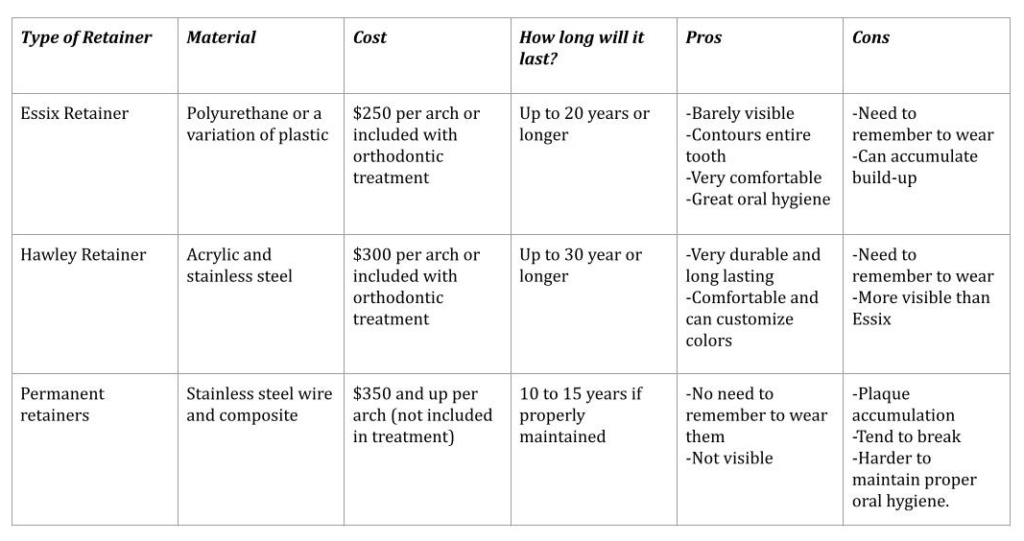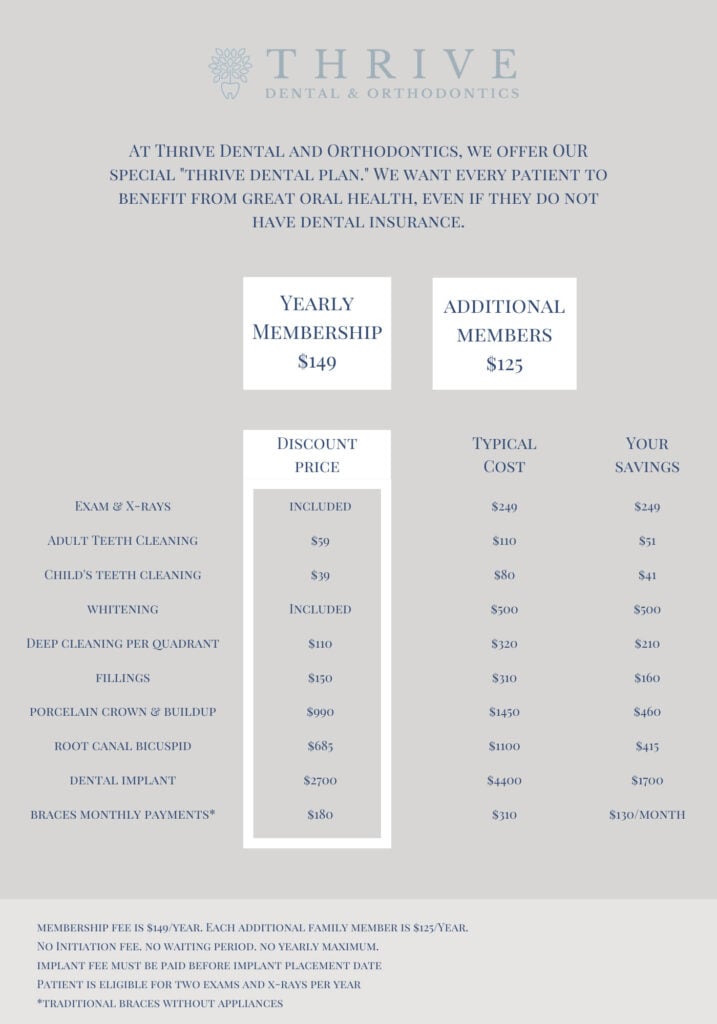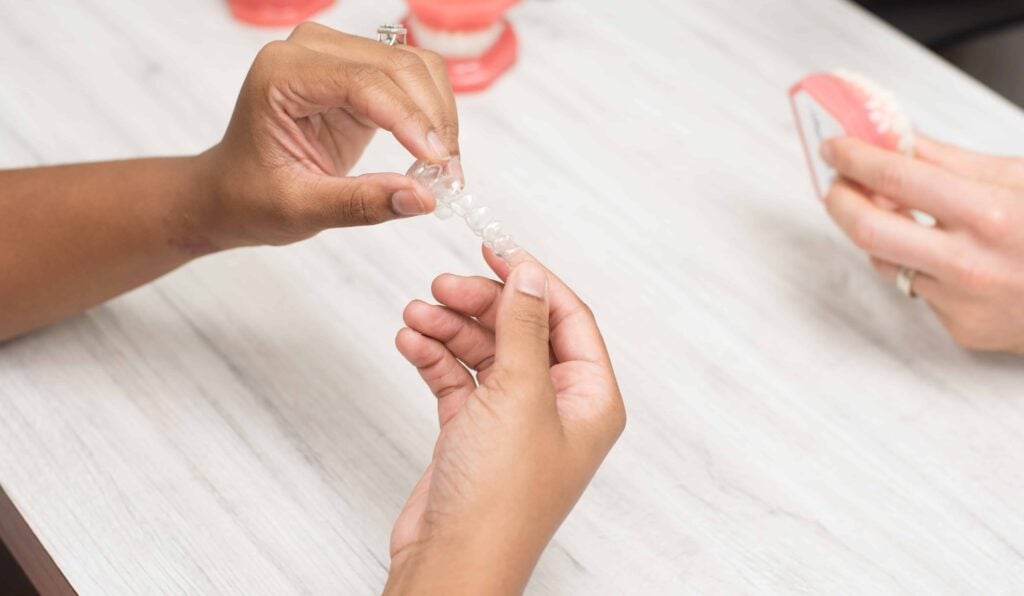A retainer is an orthodontic appliance made to keep teeth in place after braces or shift them to the correct position. It is made of either metal or plastic and custom-made to fit your teeth exactly.
There are two functions of retainers:
- Passive retainer: keeps the new position of your teeth after braces
- Active retainer: corrects minor orthodontic issues that don’t require braces.
How long are you supposed to wear your retainer? The answer is: for the rest of your life.
The cost is around $150-$1,000, depending on the type and material.
But this is usually included in the cost of braces or Invisalign treatment.
A passive retainer should be worn every day (mainly at night) after orthodontic treatment so that your teeth don’t shift back to their original spot.
There are three main types of retainers:
- Removable strong plastic retainers (Essix and Vivera)
- Hawley acrylic retainers (metal bar with acrylic)
- Permanent retainers (bonded wire in the inner surface of front teeth)
Orthodontists will give you retainers at the end of your Invisalign or braces treatment to keep your teeth in the same position. You may also receive an active retainer to treat minor crowding issues.
You will need retainers for any arch you have treated with orthodontics. We recommend Essix-style at our offices as they are the easiest to clean, and you have the best oral health.
Below is a chart comparing different retainer types by material, cost, expected lifetime, pros, and cons.

Fitting your new retainer
To properly fit your retainer, we will take an alginate impression of your mouth. Alginate is the thick material we use for this purpose. This impression typically takes less than sixty seconds.
The impressions will be taken to the lab, poured, and made into a dental cast. This cast is what is used to make your custom appliance.
The process is painless, and if we can fabricate your retainers in our offices, they may be ready the same day or within a few days.
Adjusting to new retainers
It is sometimes awkward adjusting to a new retainer. Some patients may slur their speech or salivate more than before. These are typical experiences that will go away with time.
If you are slurring your speech, try talking in front of a mirror to get used to having an appliance in your mouth. The more comfortable you get with the new appliance, the quicker you will adjust your speech.
Why does my retainer hurt my teeth?
Retainers can cause tooth soreness, which will go away with time. If you wear your retainers consistently, your teeth will adjust to the retainer’s position and no longer cause discomfort.
The retainers cause your teeth to hurt because your teeth have likely shifted slightly since your impression was taken.
Teeth shift because the ligaments (periodontal ligaments) that hold your teeth in place have memory. Your teeth want to move back to their original position; therefore, when you no longer have braces or Invisalign in your mouth, the teeth tend to relapse.
The relapse is minor, so your retainers can shift your teeth back to the position they were in when you initially removed your braces.
You should not experience sharp pain with retainers. If the appliances are poking your gums or causing intense pain, come in so we can take a look and adjust them as needed.
How many hours a day should I wear my retainers?
Every orthodontist is different, but I recommend wearing retainers for at least twelve to fourteen hours a day for two years. This means you must wear your trays every single day.
Teeth tend to shift the most within the first six months; therefore, retainer wear is vital during that time.
After the first two years, you can shift to one to two nights a week of wear. You will keep this routine for the rest of your life.
If you notice that your teeth tend to shift even after wearing them for fourteen hours, then wear them longer. There is no such thing as wearing your retainers too much.
How long after braces should I wear my retainers?
Amazingly, I often hear patients tell me that their previous orthodontist told them only to wear their retainers for a few years, and then they are good to go without them.
Unfortunately, those same patients are in my office asking for a new set of braces or an Invisalign treatment because their teeth have shifted.
Teeth will continue to shift throughout our lifetime. Therefore, you must wear your retainers for the rest of your life. You will only need to wear them a few nights a week, but this will guarantee your teeth stay straight.
I often mention to patients at the end of treatment that they spent a lot of money and time to get a beautiful smile, and now it is up to them to keep that smile.
If you wear your retainers, your teeth will stay straight, but if you do not, there is a good chance your teeth will shift back to what they looked like before orthodontic treatment.
What happens if I stop wearing my retainer?
Teeth have ligaments that surround them. These ligaments have memory and want to shift back to their original position. Just like a rubber band, when stretched, it wants to go back to normal, and your teeth want to move back to their original position.
The few months after removing your braces are the most crucial time for wearing retainers. You may go a few days without wearing your retainer, and your teeth could shift so much that your retainers no longer fit.
Yet, if you go a few days without retainer wear years after your orthodontic treatment, you will likely still be able to fit into your old retainers. The further away from braces treatment, the less likely your teeth will relapse.
That said, your teeth are continuously moving, so make sure to wear your retainers for the rest of your life to maintain that beautiful smile.
If you completely stop wearing your retainers, your teeth will likely shift back to their original position or a version of that. If it becomes severe enough, you will need orthodontic treatment again.
Teeth relapse happens all too often. We see many adult patients who had orthodontic treatment previously and are coming in for a consult due to poor retainer wear. They often need a completely new orthodontic treatment to straighten their teeth again.
How to clean your retainer
To clean your removable retainer, make sure to:
- Brush it with warm soapy water after every use.
- Keep it soaked in a stainless steel container with distilled water
- Do not brush it with toothpaste or mouthwash
Every so often, if you have build-up on your appliance, you can use a mixture of baking soda, white vinegar, and water for fifteen minutes. This mixture will help remove excess buildup.
How much do retainers cost?
Retainer costs are included in your orthodontic treatment at our offices. Some offices may charge separately, which is absurd to me.
If you lose or break the appliance after treatment, a typical replacement cost is $250 per arch for Hawley and Essix.
Permanent retainer placement is typically not included in orthodontic treatment and may cost between $350 to $500 for initial placement and repair if needed.
Insurance typically does not cover replacement retainers but check your insurance to ensure.
Don’t have dental insurance? We’ve got you, friend.
Take advantage of our Thrive Dental Discount Plan, which offers significant discounts on dental services for an annual fee of only $149.
We believe everyone deserves excellent dental care and that it should be affordable.

You can also get Vivera retainers from Invisalign. These typically come in multiple sets and cost $500 to $750 as you receive numerous retainers.
If you feel like you will lose your retainers, ask your orthodontist for multiple sets as soon as you take off your braces. Numerous retainers add more insurance because you have an immediate backup if you lose or break.
Final thoughts on retainers
There are three types of retainer: 1. Essix (Vivera), 2. Hawley and 3. Permanent retainers. Each has its pros and cons, but we mainly use Essix-style retainers at our Thrive offices.
It is vital to wear your appliance for at least 14 hours a day for the first two years and a few nights a week for the rest of your life.
If you do not wear your retainers, there is a high likelihood that your teeth will shift back. When you do not wear your retainers, your teeth will likely shift, and you may need orthodontic treatment again. If your teeth shift a small amount, you may wear an active retainer to bring your teeth back into the proper position.
Wearing your retainers is an easy way to keep your smile looking beautiful. Remember, you spent a lot of time and money to get your teeth straight, so be sure to keep them that way with proper appliance wear.
If you need new retainers or want to come in for a consult, book now!



